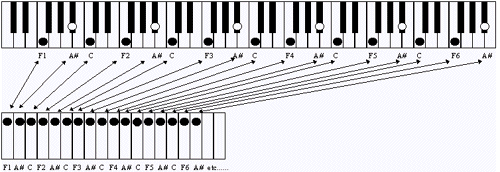|
|
|
|
Jimmy Hotz - His Music and Inventions - Free
MP3 Files
OVERVIEW
TRANSLATOR-BASED
PRODUCTS ENABLE ANYBODY TO PLAY MUSIC Created with the Hotz Translator for Windows, a Hotz-file contains information that translates all of the correct notes of the current chord and scale (musical "structure") for the musical piece being played into rows on the playing surface. The "instrument" can be the computer's keyboard and mouse, or an electronic keyboard or other type of MIDI instrument connected to the computer through its MIDI port (the joystick port on the sound card). In real time, as the musical key, scales and chords change so does the translation of the playing surface. The end result is that players have all the creative choices they would have with a conventional musical instrument they practiced for years, but without fear of choosing a "wrong," or out-of-key note. By this simple and elegant process, Hotz Translator technology reduces years of practice and study needed to experience creative music improvisation and performance. Moreover, it allows musicians who have played all their lives to perform music at a level that is impossible on a conventional instrument. CONTAINS
THE LARGEST DATABASE OF MUSICAL STRUCTURES Songs of any style and ethnic origin can have Hotz-files created to translate the playing surface to the chord/scale structures as the song plays. Through a computer sound card, the sound produced can be that of virtually any instrument in the world. It is important to note that the cost of creating Hotz-coded files for music-CDs is quite low. The level of development effort is typically less than one person-day per music track for a trained music technician, depending on the length and musical complexity. Expansion of notes for an F suspended 4th chord on a standard 6-octave keyboard.
Prior attempts to change note mapping tables in real-time sound choppy and toy-like because all notes from the previous table have to be turned off when the change takes place. The Hotz Corporation's broad patent protection includes the fundamental Translation process, which separates Translator-based products from toy-like musical devices. Any musical instrument that aims to provide users with similar music performance features would have to incorporate this core technology to deliver realistic improvisational control. The Hotz coding process
automates the structure/table changes without requiring the user
to do anything but concentrate on playing music. Thus the user
can focus completely on which notes of a particular chord or scale
should be played and for how long, which is the very essence of
music performance. Structure changes can be under pre-encoded
software control, or made by the player as a real-time composer.
For those who have never played, the result is real improvisational
ability impossible without decades of study and practice. And
for those who have played for years, the result is the ability
to perform at levels that are simply not possible using conventional
instruments. |
| Buy at the Hotz Store |
| Contact | Copyright Jimmy Hotz
Productions 2007 all rights reserved |

